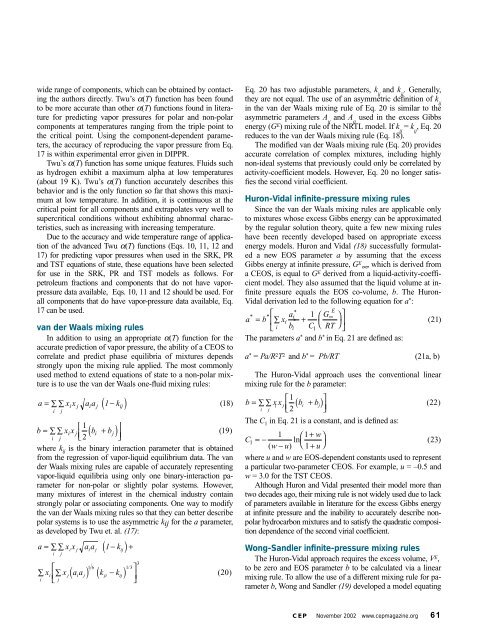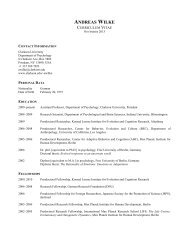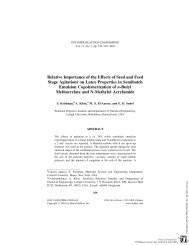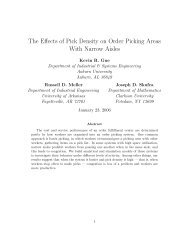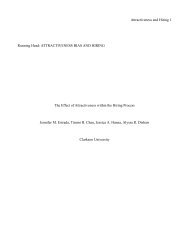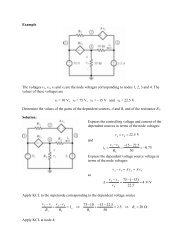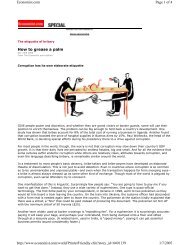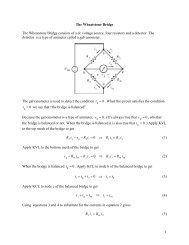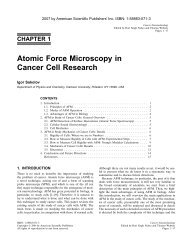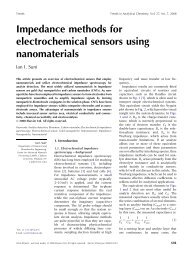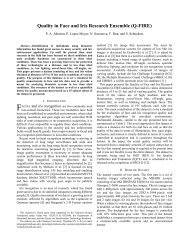Getting a Handle on Advanced Cubic Equations of State
Getting a Handle on Advanced Cubic Equations of State
Getting a Handle on Advanced Cubic Equations of State
Create successful ePaper yourself
Turn your PDF publications into a flip-book with our unique Google optimized e-Paper software.
wide range <strong>of</strong> comp<strong>on</strong>ents, which can be obtained by c<strong>on</strong>tacting<br />
the authors directly. Twu’s α(T) functi<strong>on</strong> has been found<br />
to be more accurate than other α(T) functi<strong>on</strong>s found in literature<br />
for predicting vapor pressures for polar and n<strong>on</strong>-polar<br />
comp<strong>on</strong>ents at temperatures ranging from the triple point to<br />
the critical point. Using the comp<strong>on</strong>ent-dependent parameters,<br />
the accuracy <strong>of</strong> reproducing the vapor pressure from Eq.<br />
17 is within experimental error given in DIPPR.<br />
Twu’s α(T) functi<strong>on</strong> has some unique features. Fluids such<br />
as hydrogen exhibit a maximum alpha at low temperatures<br />
(about 19 K). Twu’s α(T) functi<strong>on</strong> accurately describes this<br />
behavior and is the <strong>on</strong>ly functi<strong>on</strong> so far that shows this maximum<br />
at low temperature. In additi<strong>on</strong>, it is c<strong>on</strong>tinuous at the<br />
critical point for all comp<strong>on</strong>ents and extrapolates very well to<br />
supercritical c<strong>on</strong>diti<strong>on</strong>s without exhibiting abnormal characteristics,<br />
such as increasing with increasing temperature.<br />
Due to the accuracy and wide temperature range <strong>of</strong> applicati<strong>on</strong><br />
<strong>of</strong> the advanced Twu α(T) functi<strong>on</strong>s (Eqs. 10, 11, 12 and<br />
17) for predicting vapor pressures when used in the SRK, PR<br />
and TST equati<strong>on</strong>s <strong>of</strong> state, these equati<strong>on</strong>s have been selected<br />
for use in the SRK, PR and TST models as follows. For<br />
petroleum fracti<strong>on</strong>s and comp<strong>on</strong>ents that do not have vaporpressure<br />
data available, Eqs. 10, 11 and 12 should be used. For<br />
all comp<strong>on</strong>ents that do have vapor-pressure data available, Eq.<br />
17 can be used.<br />
van der Waals mixing rules<br />
In additi<strong>on</strong> to using an appropriate α(T) functi<strong>on</strong> for the<br />
accurate predicti<strong>on</strong> <strong>of</strong> vapor pressure, the ability <strong>of</strong> a CEOS to<br />
correlate and predict phase equilibria <strong>of</strong> mixtures depends<br />
str<strong>on</strong>gly up<strong>on</strong> the mixing rule applied. The most comm<strong>on</strong>ly<br />
used method to extend equati<strong>on</strong>s <strong>of</strong> state to a n<strong>on</strong>-polar mixture<br />
is to use the van der Waals <strong>on</strong>e-fluid mixing rules:<br />
a = ∑ ∑ x x a a 1−k i<br />
where kij is the binary interacti<strong>on</strong> parameter that is obtained<br />
from the regressi<strong>on</strong> <strong>of</strong> vapor-liquid equilibrium data. The van<br />
der Waals mixing rules are capable <strong>of</strong> accurately representing<br />
vapor-liquid equilibria using <strong>on</strong>ly <strong>on</strong>e binary-interacti<strong>on</strong> parameter<br />
for n<strong>on</strong>-polar or slightly polar systems. However,<br />
many mixtures <strong>of</strong> interest in the chemical industry c<strong>on</strong>tain<br />
str<strong>on</strong>gly polar or associating comp<strong>on</strong>ents. One way to modify<br />
the van der Waals mixing rules so that they can better describe<br />
polar systems is to use the asymmetric kij for the a parameter,<br />
as developed by Twu et. al. (17):<br />
a = ∑ ∑ xixj aa i j ( 1−kij)+ i<br />
j<br />
b = x x<br />
⎡1<br />
∑ ∑ i j b + b<br />
i j ⎣⎢ 2<br />
j<br />
i j<br />
( )<br />
i j ij<br />
( i j)<br />
⎤<br />
⎦⎥<br />
( ) ( − )<br />
⎡<br />
∑ x ⎢∑<br />
x aa k k<br />
i ⎣ j<br />
i j i j ji ij<br />
⎤<br />
⎥<br />
⎦<br />
16 13 3<br />
/<br />
( 18)<br />
( 19)<br />
( 20)<br />
Eq. 20 has two adjustable parameters, k ij and k ji . Generally,<br />
they are not equal. The use <strong>of</strong> an asymmetric definiti<strong>on</strong> <strong>of</strong> k ij<br />
in the van der Waals mixing rule <strong>of</strong> Eq. 20 is similar to the<br />
asymmetric parameters A ij and A ij used in the excess Gibbs<br />
energy (G E ) mixing rule <strong>of</strong> the NRTL model. If k ij = k ij , Eq. 20<br />
reduces to the van der Waals mixing rule (Eq. 18).<br />
The modified van der Waals mixing rule (Eq. 20) provides<br />
accurate correlati<strong>on</strong> <strong>of</strong> complex mixtures, including highly<br />
n<strong>on</strong>-ideal systems that previously could <strong>on</strong>ly be correlated by<br />
activity-coefficient models. However, Eq. 20 no l<strong>on</strong>ger satisfies<br />
the sec<strong>on</strong>d virial coefficient.<br />
Hur<strong>on</strong>-Vidal infinite-pressure mixing rules<br />
Since the van der Waals mixing rules are applicable <strong>on</strong>ly<br />
to mixtures whose excess Gibbs energy can be approximated<br />
by the regular soluti<strong>on</strong> theory, quite a few new mixing rules<br />
have been recently developed based <strong>on</strong> appropriate excess<br />
energy models. Hur<strong>on</strong> and Vidal (18) successfully formulated<br />
a new EOS parameter a by assuming that the excess<br />
Gibbs energy at infinite pressure, GE ∞ , which is derived from<br />
a CEOS, is equal to GE derived from a liquid-activity-coefficient<br />
model. They also assumed that the liquid volume at infinite<br />
pressure equals the EOS co-volume, b. The Hur<strong>on</strong>-<br />
Vidal derivati<strong>on</strong> led to the following equati<strong>on</strong> for a * :<br />
The parameters a * and b * a b x<br />
in Eq. 21 are defined as:<br />
a<br />
* * ⎡ *<br />
i<br />
= ⎢∑<br />
i *<br />
⎣ i bi 1 G<br />
+<br />
⎛ ∞ ⎞ ⎤<br />
C ⎝ RT ⎠ ⎥<br />
1 ⎦<br />
( 21)<br />
a * = Pa/R 2 T 2 and b * = Pb/RT (21a, b)<br />
The Hur<strong>on</strong>-Vidal approach uses the c<strong>on</strong>venti<strong>on</strong>al linear<br />
mixing rule for the b parameter:<br />
b = xx<br />
⎡1<br />
∑ ∑ i j b i + b<br />
⎤<br />
( j)<br />
i j ⎣⎢ 2 ⎦⎥<br />
The C1 in Eq. 21 is a c<strong>on</strong>stant, and is defined as:<br />
E<br />
( 22)<br />
1 w<br />
C =−<br />
⎛1+<br />
⎞<br />
1<br />
ln<br />
( 23)<br />
( w−u) ⎝ 1 + u ⎠<br />
where u and w are EOS-dependent c<strong>on</strong>stants used to represent<br />
a particular two-parameter CEOS. For example, u = –0.5 and<br />
w = 3.0 for the TST CEOS.<br />
Although Hur<strong>on</strong> and Vidal presented their model more than<br />
two decades ago, their mixing rule is not widely used due to lack<br />
<strong>of</strong> parameters available in literature for the excess Gibbs energy<br />
at infinite pressure and the inability to accurately describe n<strong>on</strong>polar<br />
hydrocarb<strong>on</strong> mixtures and to satisfy the quadratic compositi<strong>on</strong><br />
dependence <strong>of</strong> the sec<strong>on</strong>d virial coefficient.<br />
W<strong>on</strong>g-Sandler infinite-pressure mixing rules<br />
The Hur<strong>on</strong>-Vidal approach requires the excess volume, V E ,<br />
to be zero and EOS parameter b to be calculated via a linear<br />
mixing rule. To allow the use <strong>of</strong> a different mixing rule for parameter<br />
b, W<strong>on</strong>g and Sandler (19) developed a model equating<br />
CEP November 2002 www.cepmagazine.org 61


